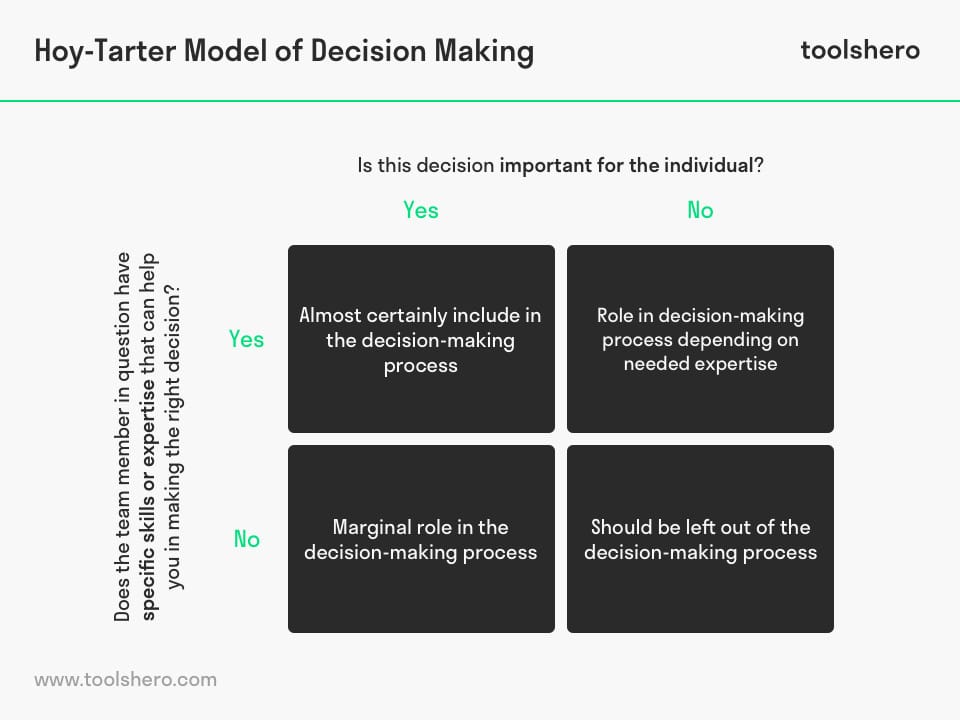Hoy-Tarter Model of Decision Making

Hoy-Tarter Model of Decision Making: this article offers a practical explanation of the Hoy-Tarter Model of Decision Making. After reading, you will gain a better understanding on how best to select the right team members for the decision-making process. The main objective in this model is to find out exactly who should be included in the decision-making process.
What is the Hoy-Tarter Model of Decision Making?
The Hoy-Tarter Model of Decision Making can be applied in different environments. As the manager of an organisation, you know all too well how difficult it can be to make decisions. It can especially be difficult to decide how to make these decisions, like who to include and what to consider in the process, for example.
Making good decisions is key to success in business; as such, an appropriate process is important to keep in mind.
Why the Hoy-Tarter Model of Decision Making?
Different decisions need different input from different people, so it is important to determine who should (and who should not) be included in making the decision. Including the wrong people, or not including the right ones, can have major consequences for the organisation.
Applications of the Hoy-Tarter Model of Decision Making
You can apply this approach in different situations. Examples include:
- Recruitment interviews
- Team development and motivation
- Collecting requirements for projects, such as IT development.
- Market research
- Developing business strategy
- Guidance
- Conflict resolution
Getting Started with The Hoy-Tarter Model of Decision Making
The Matrix
The first step of using the Hoy-Tarter Model of Decision Making is to think about all team members. This is done in relation to a matrix with four quadrants that allows you to determine whether a person should be included.
Two questions are used for this purpose, both of which are answered with a ‘yes’ or ‘no’. On one side of the matrix is the question of how much personal commitment each team member has in the decision to be made.
Is this decision important for the individual, or is it something that does not affect them in a significant way? Answer this question is with a yes or a no – yes if the decision affects the team member, and no if it does not.
On the other side of the Hoy-Tarter Model of Decision Making matrix is the question of expertise. Does the team member in question have specific skills or expertise that can help you in making the right decision? Again, it’s a yes or no answer which will help you place the team member in one of the four quadrants.
A ‘yes’ answer is an indication of a certain team member having expertise that you think would be useful, while a ‘no’ answer is an indication of someone who does not put much on the table in terms of experience or knowledge (in relation to this particular decision).
The Four Options
It should be clear that if you have two questions with two possible answers each, you have four possibilities for each team member you’re evaluating as a part of this process. The four results within the Hoy-Tarter Model of Decision Making are as follows:
Expertise – Yes, personal commitment – Yes.
If the team member receives a yes answer to both questions, that person should almost certainly be included in the decision-making process.
They will provide expertise that should be useful for helping you to make your decision, and they are going to work hard on the problem because they have a personal interest in the outcome. This is exactly the kind of person you want to have with you if you want to make an important decision, so that person clearly needs to be included.
Expertise – No, personal commitment – Yes.
Within the Hoy-Tarter Model of Decision Making, this is a person who qualifies for a marginal role in the decision-making process.
On the one hand, they don’t really have the expertise to help you make the right choice from a technical perspective. On the other hand, they are interested in the outcome and will probably work hard to steer the company in the right direction.
Although this is probably not the kind of person you would like to have play an important role in the decision-making process, that person may be considered for a partial role to help you come to the right conclusion. This person can be especially useful if you already have a team that consists of people with a lot of expertise but with minimal personal commitment in the matter.
Expertise – Yes, personal commitment – No.
In the Hoy-Tarter Model of Decision Making, this is another category of individuals that should be considered, but it should only be included if their expertise is something that can have a major impact on the decision-making process. Does the person have knowledge and experience that would otherwise not exist in your team?
If so, they absolutely must be included in some form or fashion. Otherwise, they may have to be omitted because their lack of personal commitment reduces their motivation and the project will suffer.
Expertise – No, personal commitment – No.
It should surprise no one that this category of team members should be left out of the decision-making process altogether.
If they do not offer anything from the point of view of expertise, and they have no personal interest in the decision, they really have nothing to do with it. You don’t want to unnecessarily overwhelm the process with too many votes, so keep these people away from your meetings.
Although more steps can be included in this process, for managers and business owners, this first way of thinking is especially important. You want to make sure that your decisions are made as intelligently as possible, and much of the work spent on that goal is using the right members of your team to make the choice.
Do you think you’ve added the right people to your decision-making meetings, or are you going to make some changes in light of the points that this model presents?
It’s hard to guide an organisation towards the future without making smart decisions, and it’s hard to make smart decisions without the right people working with you on the project. If applicable, use the Hoy-Tarter Model of Decision Making to select the right team members for a decision-making process, and your choices should be better for the effort.
Now It’s Your Turn
What do you think? Do you recognise the explanation regarding the Hoy-Tarter Model of Decision Making or do you have anything to add to this explanation? When do you think this model is effective? What do you believe are success factors that contribute to the practical application of this theory?
Share your experience and knowledge in the comments box below.
More information
- Binda Zane, E. (2016) Effective Decision-Making: How to Make Better Decisions Under Uncertainty and Pressure.
- Hoy, W. K. (1995). Administrators solving the problems of practice: Decision-making concepts, cases, and consequences. Allyn & Bacon.
- Sabo, D. J., Barnes, K., & Hoy, W. K. (1996). Organizational health and decision participation: An empirical analysis of healthy interpersonal dynamics and teacher participation. Journal of School Leadership, 6(6), 576-599.
- Sweetland, S. R., & Hoy, W. K. (2000). School characteristics and educational outcomes: Toward an organizational model of student achievement in middle schools. Educational Administration Quarterly, 36(5), 703-729.
- Taylor, D. L., & Tashakkori, A. (1994). Predicting Teachers’ Sense of Efficacy and Job Satisfaction Using School Climate and Participatory Decision Making.
How to cite this article:
Sari, J. (2019). Hoy-Tarter Model of Decision Making. Retrieved [insert date] from toolshero: https://www.toolshero.com/decision-making/hoy-tarter-model/
Add a link to this page on your website:
<a href=”https://www.toolshero.com/decision-making/hoy-tarter-model/”>toolshero: Hoy-Tarter Model of Decision Making</a>
Published on: 03/12/2019 | Last update: 03/03/2022














One response to “Hoy-Tarter Model of Decision Making”
Just wanted to say thank you TOOLSHERO so much for the huge number of models you make available so generously. I’m always short of time, and your categorisation and cross-referenced linking makes vital guidance so accessible.